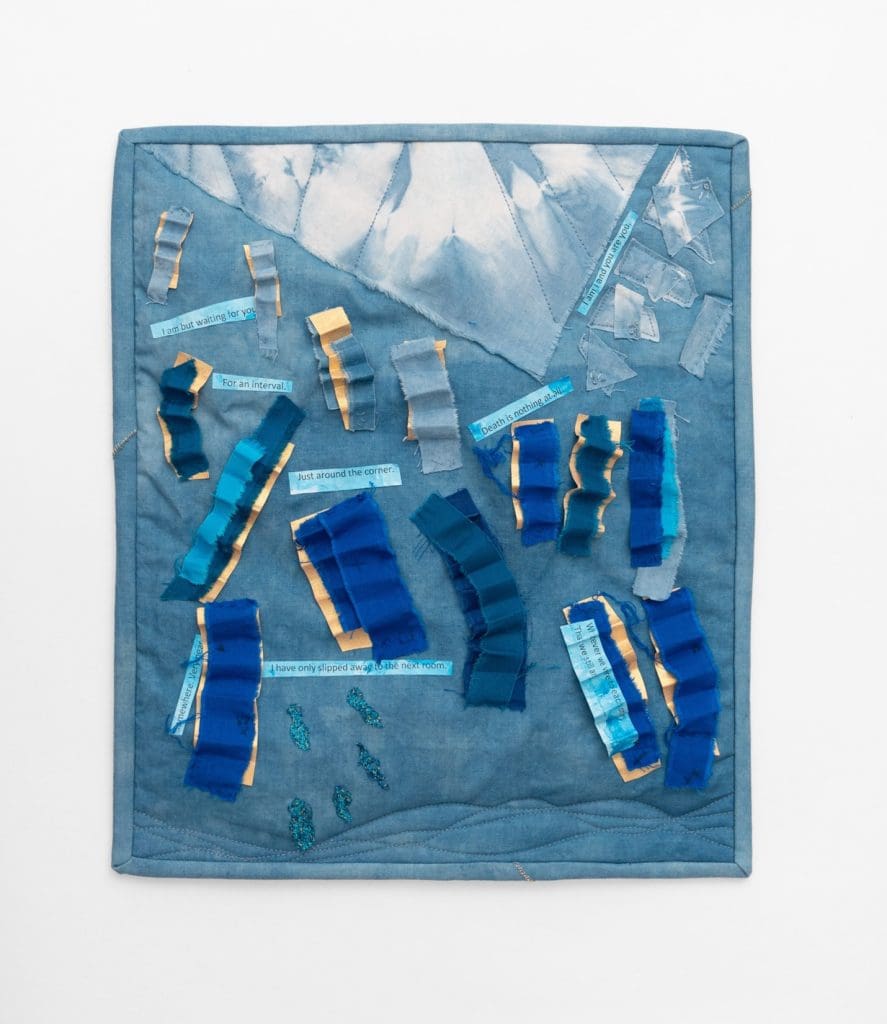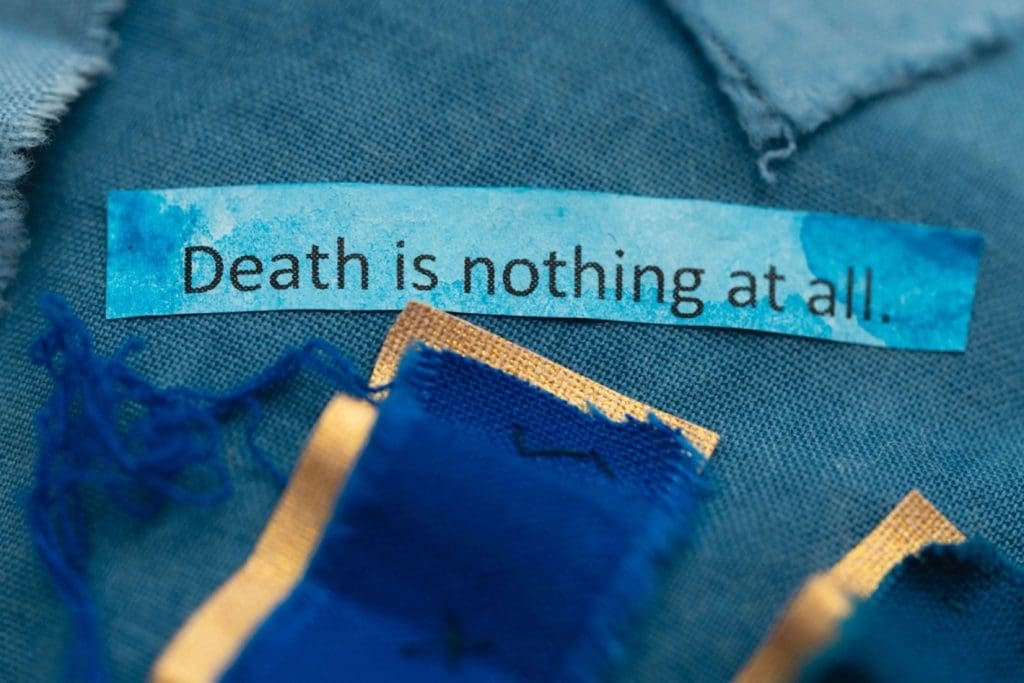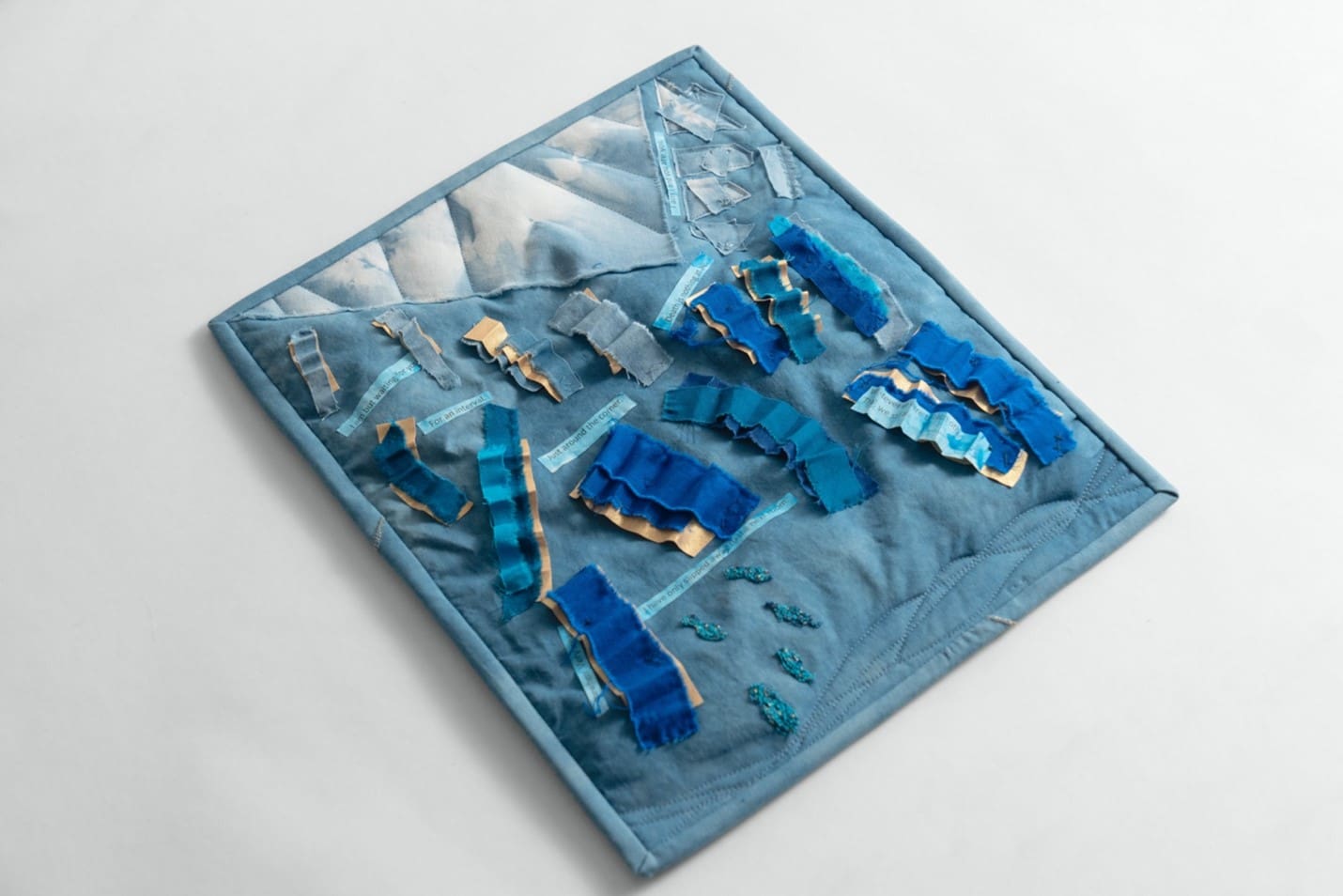You’re Still Here: Art and Grief in Autoethnographic Textiles
Artist’s Memo
You’re Still Here: Art and Grief in Autoethnographic Textiles is an essay with accompanying photographs of an autoethnographic textile artwork that expresses the grief I felt after the death of my best friend. The artwork and essay explore the profound impact that my friend’s death had on my life, an impact that others often did not recognize. My relationship with my friend had fundamentally shaped who I had become as a person, and so the grief I felt after her death was similar to what we (culturally assume) people feel after the loss of a parent or intimate partner. However, there was very little language available to me to explain this relationship to others, and what that meant for my experience of grief.
‘This is an essay with accompanying photographs of an autoethnographic textile artwork that expresses the grief I felt after the death of my best friend.
No matter how hard I tried, there was little acknowledgement from family, friends, and colleagues of how deeply her death was affecting me. I engaged in artmaking to work through, and express, my feelings related to this experience, and to help myself heal. I discovered in the process that artmaking also allowed me to understand how I could create a new relationship with my friend even in the face of her death–how I could still understand that she was with me in this life even though she wasn’t physically here.
In the essay, I provide a thick description of this exploration of my personal experience while at the same time highlighting and interrogating cultural expectations and social norms related to grief and death. In doing so, I encourage the reader to reflect on how they personally respond to death in their own lives and the lives of others, what this means for how we grieve individually and collectively, and we how we can keep and build relationships with those we have loved and lost. Together, this essay and accompanying textile artwork reveal the power of autoethnographic artmaking as a means to engage in personal healing while simultaneously speaking to our complex and varied social experiences.
‘The artwork and essay explore the profound impact that my friend’s death had on my life…

You’re Still Here is a textile artwork that expresses the profound grief I have felt since the death of my best friend. Profound grief changes us. It can overwhelm, and it can clarify. Her death fundamentally altered my life.
In the hospice, I was with her for hours watching her cough and hearing the death rattle in her breath continue to build. I held her hand. I grabbed it so tightly it should have hurt her; she should have asked me to stop. But she didn’t. She didn’t make a sound, and I didn’t know what to do next.
‘You’re Still Here is a textile artwork that expresses the profound grief I have felt since the death of my best friend.
Two years after my friend died, I travelled across the country to hold my mom’s hand while she was dying. It was a quieter death than my friend’s. My mom took a slow breath, and then her next breath just never came. Both deaths rocked me: both changed how I understood my life and who I was. Both have come with deep, enduring grief.

When my mom died, people understood. My work sent flowers. I received condolences and was granted bereavement leave. People shared their stories of my mom and their own stories of losing a parent. It was understood that my life would never be the same again. It was understood that I couldn’t go back to who I was before I lost my mom.
‘In the hospice, I was with her for hours watching her cough and hearing the death rattle in her breath continue to build.
When my friend died, I received one or two cards from people who knew we were close, and I had to keep working. There was no bereavement leave for the category of “friend” so I pushed through even though I could barely lift my head. When I said to friends and colleagues that “I held the hand of my friend while she was dying,” the depth of my grief was unrecognizable to them. I felt unsure of how to convey what it meant to hear her death rattle and watch her cough up blood. It was an open, gaping wound that others weren’t able to recognize, and the invisibility of my grief made it so much more difficult to figure out how to heal. Eventually, I turned towards artmaking.

I have known how to sew since I was a young child, but the profound impact of channeling this skill into abstract textile art is a recent discovery. I find inspiration to create art in exploring how my life stories are entangled with the stories of others and I aim to create work that is multidimensional, imperfect, and a bit raw, which is a genuine representation of the way I feel at this time in my life. While I had thought about making a textile art piece about my friend’s death sooner, it took me six years of grieving to finally be able to create it.
‘While I had thought about making a textile art piece about my friend’s death sooner, it took me six years of grieving to finally be able to create it.
My friend died in 2017. Years before her death I moved across the country, away from her, for work. We remained close, talking regularly and ending each conversation with the words “always in your pocket” to remind each other that, despite the distance, we were still connected. When she died, I felt utterly lost. My pockets no longer felt big enough to hold us together across the expanse of space/time we call life and death.

You’re Still Here represents the comfort I found in visualizing our spirits, along with our memories, floating together in deep, calm ocean waters, kept safe and being kept together by the transcendent life force of water. The written phrases included in the artwork are from the poem Death Is Nothing At All by Henry Scott Holland. When she was dying, my friend asked that this poem be read during her funeral to provide comfort, assuring us that she had only “slipped away to the next room.” I read the poem at her funeral and, for me, it was the start of a long personal journey to figure out how I could live that new version of life–the one where she was in the next room, but she wasn’t.
‘When she died, I felt utterly lost. My pockets no longer felt big enough to hold us together across the expanse of space/time we call life and death.
The paper used in this artwork is the exact copy of the poem that I held in my shaking hands at the funeral. It is the same paper that soaked up my tears as I read the poem aloud. Six years later I cut it up. Re-worked it. Re-made it and made new meaning. Artmaking can be such a profoundly healing process.

In You’re Still Here I decided to keep most of the fabric edges raw, unfinished, and frayed to provide a highly organic and textural quality that, to me, is reminiscent of the experience of grieving and being so close to death. Thread “tears” float softly in the dark, quiet water right near the ocean floor. These tears were created by combining six different types of thread using free machine embroidery, a technique that my mom taught me prior to her death. The tears were then hand sewn to the background fabric with gold thread illustrating the value of crying and moving emotion through the body to help us process profound grief.
‘In You’re Still Here I decided to keep most of the fabric edges raw, unfinished, and frayed to provide a highly organic and textural quality that, to me, is reminiscent of the experience of grieving and being so close to death.
Creating You’re Still Here helped me to grieve and heal, and to discover new ways to keep connected with my friend even in the face of death. It was also created for everyone else who is grieving. For those who are mourning deep meaningful relationships that changed who they were regardless of whether other people understand. I am hopeful that You’re Still Here brings some comfort. That it speaks to you and you can hear it say: “I see your grief and I understand its depth,” and that it encourages a brave spirit that supports us all to fully feel our grief while simultaneously finding our own ways to build new relationships with those we have loved and lost.
Credits
The artwork by Rebecca Godderis
The photographs of artwork by Christina De Melo
Learn More
New to autoethnography? Visit What Is Autoethnography? How Can I Learn More? to learn about autoethnographic writing and expressive arts. Interested in contributing? Then, view our editorial board’s What Do Editors Look for When Reviewing Evocative Autoethnographic Work?. Accordingly, check out our Submissions page. View Our Team in order to learn about our editorial board. Please see our Work with Us page to learn about volunteering at The AutoEthnographer. Visit Scholarships to learn about our annual student scholarship competition
Rebecca Godderis, PhD, is a textile artist and Associate Professor that teaches about intersectional feminism and community building. Her most recent work explores relationships between personal healing and collective liberation with a specific focus on grief, death, and vulnerability.









